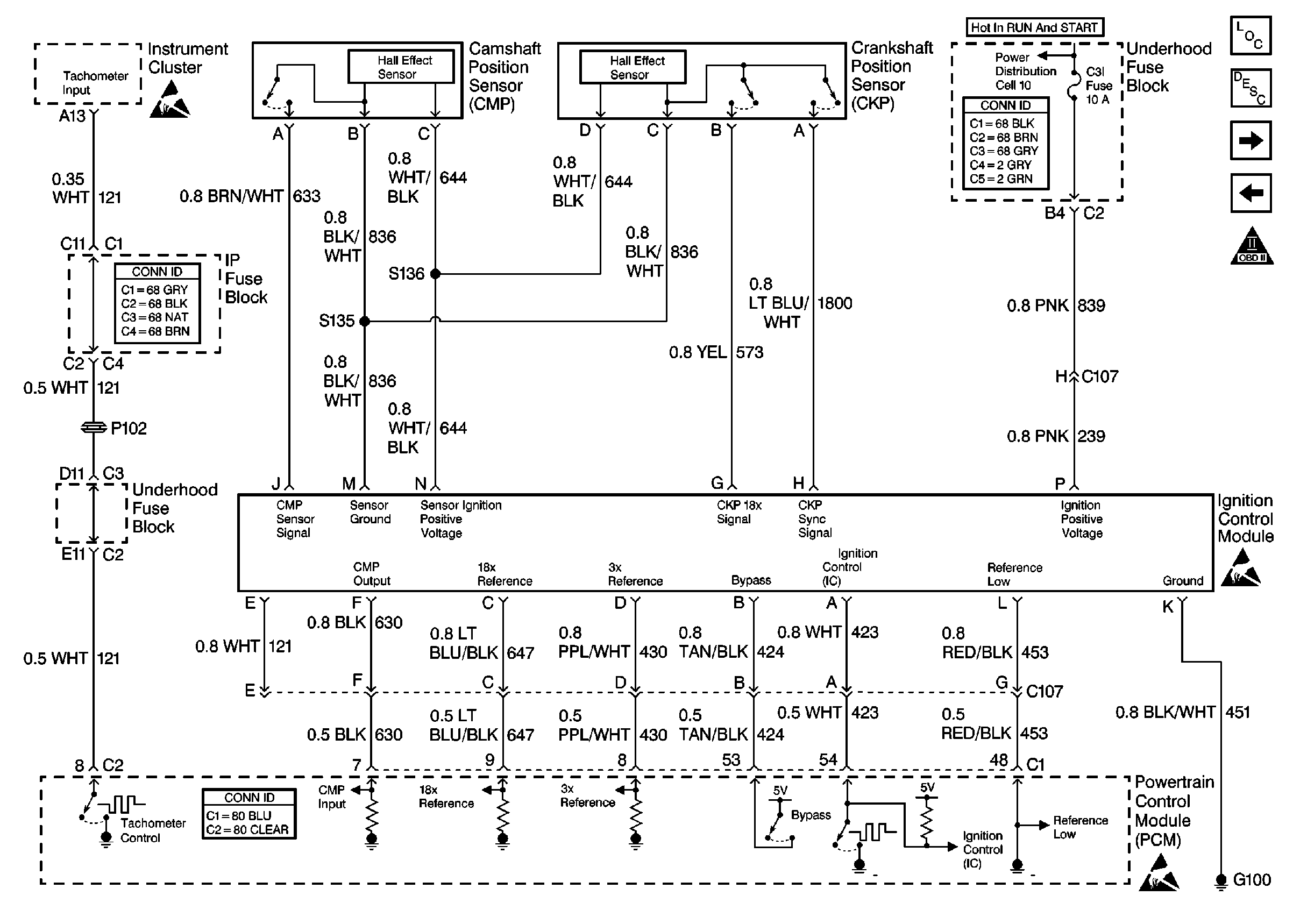Refer to
Cell 20: Ignition Control

for a wiring diagram.
Circuit Description
The 3X reference signal is produced by the ignition control module. The ICM calculates the 3X reference signal by dividing the Crankshaft Position (CKP) sensor 18X pulses by 3 when the engine is running and CKP sync pulses are also being received. The PCM uses the 3X reference signal to calculate engine rpm and crankshaft position at engine speeds above 1200 rpm. The PCM also uses the pulses on this circuit to initiate injector pulses. The PCM constantly monitors the number of pulses on the 3X reference circuit and compares the number of 3X reference pulses to the number of 18 X reference pulses and CAM signal pulses being received. If the PCM receives an incorrect number of pulses on the 3X reference circuit, DTC P1374 will set and the PCM will use the 18X reference signal circuit for fuel and ignition control. The engine will continue to start and run using the 18X reference and Camshaft Position PCM input signals only.
Conditions for Running the DTC
The engine has been running for longer than 3 seconds.
Conditions for Setting the DTC
| • | The ratio of 18X reference pulses to CAM signal pulses received by the PCM equals 36:1. |
| • | The ratio of 18X reference pulses to 3X reference pulses received by the PCM does not equal 6:1. |
| • | The above conditions are present for up to 30 seconds. |
Action Taken When the DTC Sets
| • | The PCM will illuminate the malfunction indicator lamp (MIL) during the second consecutive trip in which the diagnostic test has been run and failed. |
| • | The PCM will store conditions which were present when the DTC set as Freeze Frame/Failure Records data. |
Conditions for Clearing the MIL/DTC
| • | The PCM will turn OFF the malfunction indicator lamp (MIL) during the third consecutive trip in which the diagnostic has run and passed. |
| • | The history DTC will clear after 40 consecutive warm-up cycles have occurred without a malfunction. |
| • | The DTC can be cleared by using a scan tool. |
Diagnostic Aids
An intermittent may be caused by a poor connection, rubbed through wire insulation or a wire broken inside the insulation. Check for the following conditions:
| • | Poor connection. |
| Inspect the PCM harness and connectors for improper mating, broken locks, improperly formed or damaged terminals, and poor terminal to wire connection. |
| • | Damaged harness. |
| Inspect the wiring harness for damage. If the harness appears to be OK, disconnect the PCM, turn the ignition ON and observe a voltmeter connected to the 3X reference circuit at the PCM harness connector while moving connectors and wiring harnesses related to the ICM. A change in voltage will indicate the location of the malfunction. |
| • | Malfunctioning Ignition Coil. |
| Important: If carbon tracking is detected on any component replace that component and its mate. |
| • | Remove the ignition coils and inspect the ignition control module and coils for cracks, carbon tracking, or other signs that indicate that the coil secondary circuit is arcing to the ICM or ICM wiring harness. Refer to Ignition Coil Replacement Ignition Coil(s) Replacement . |
| • | Secondary ignition wire(s) arcing to wiring harness. |
| Important: If carbon tracking is detected on any component replace that component and its mate. |
| • | Check secondary ignition wires for carbon tracking or other signs of damage. |
Reviewing the Fail Records vehicle mileage since the diagnostic test last failed may help determine how often the condition that caused the DTC to be set occurs. This may assist in diagnosing the condition.
Test Description
Number(s) below refer to the step number(s) on the Diagnostic Table.
Step | Action | Value(s) | Yes | No | ||||||||||||
|---|---|---|---|---|---|---|---|---|---|---|---|---|---|---|---|---|
1 | Was the Powertrain On-Board Diagnostic (OBD) System Check performed? | -- | ||||||||||||||
2 | Attempt to start the engine. Does the engine start and continue to run? | -- | ||||||||||||||
3 |
Does the scan tool indicate DTC P1374 failed this ignition? | -- | Go to Diagnostic Aids | |||||||||||||
4 |
Does the injector test lamp blink? | -- | ||||||||||||||
5 |
Was a problem found? | -- | ||||||||||||||
6 |
Was a problem found? | -- | ||||||||||||||
7 |
Was a problem found? | -- | ||||||||||||||
8 |
Was a problem found? | -- | ||||||||||||||
9 | Replace the ignition control module. Refer to Ignition Control Module Replacement . Is action complete? | -- | -- | |||||||||||||
|
Important:: The replacement PCM must be programmed. Replace the PCM. Refer to Powertrain Control Module Replacement/Programming . Is action complete? | -- | -- | ||||||||||||||
11 |
Does the scan tool indicate DTC P1374 failed? | -- | System OK |
